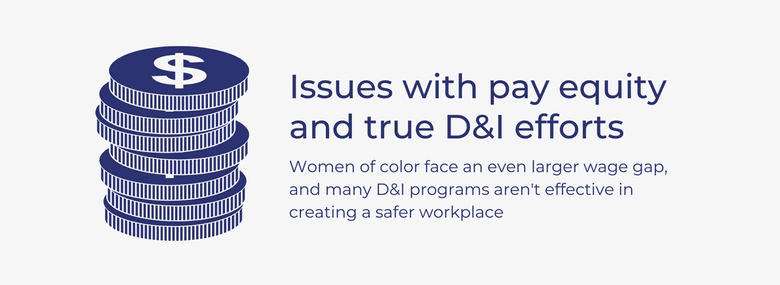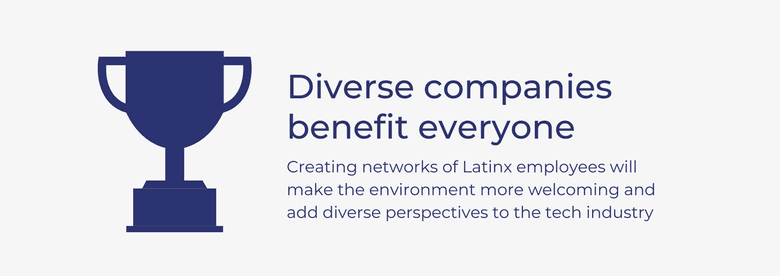How the Tech Industry is Failing the Latinx Community
Understanding the barriers Latinos face in tech
This past decade has brought growing diversity efforts across the tech industry. Throughout this time, companies have aimed to prove how they are not only advocating for their products, but for you too. For years, this industry has been a notoriously white and male environment and has gatekept from many communities and individuals. But now that tech companies are trying to emphasize accessibility and opportunities, it’s not just about getting to where you want to go, but thriving in the environment once you get there.
Breaking In

As of July 2019, the Hispanic/Latino population of the United States has grown up to 60.6 million people, or 18.5 percent of the entire U.S. population, according to the United States Census Bureau. Yet, Latinos in the U.S are still incredibly underrepresented in tech. 2014 statistics from the U.S. Equal Employment Opportunity Commission (EEOC) show that Hispanics made up eight percent of the high-tech sector and 13.9 percent in the private sector.
The tech industry is competitive, especially today. To make matters more complicated, Latinos face barriers like biases during the hiring process, lack of networking opportunities, inflexible work-life balance, being stereotyped and more. While some professionals may wander into their occupations to discover their passions, barriers like these apply pressure on potential employees to excel while facing a list of disadvantages.
Eligibility requirements for hiring processes within big tech companies, whether they are for internships, programs or permanent job positions, pose challenges to many. Facebook University, an eight-week internship program at Facebook, is one example of a attempt at diversity that falls short. The program seeks to encourage individuals from underrepresented communities to get involved and thrive in the tech industry. But one of the application requirements is enrollment in a four-year program in the United States. Even though statistics from 2018 show that 71.1 percent of college students in the U.S. attend four-year programs, only 16 percent of Latinos earn a bachelor’s degree.
Google has also pledged to help the Latinx community through programs like Laboratoria, a bootcamp supported by Google volunteers and a Google.org grant, and a grant awarded by Google to the YWCA, Hispanic Heritage Foundation and UnidosUS. But in Google’s 2020 Diversity Report, only 6.6 percent of new hires identified as Latinx. 4.3 percent were Latino and 2.3 percent were Latina, compared to the 43.1 percent new hires that identified as white. This report also showed that Latinx leadership representation within Google is a mere 3.7 percent, 1.5 percent being Latinas.
Even applying for an internship for Google poses challenges. A summer 2021 engineering internship application for Google in California asks applicants to be enrolled in a Master’s degree program in information science or a related technical field. The gap in higher education presents an automatic issue: as of 2016, only 5% of Latinx Americans had a Master's Degree, compared to 13.4% of white Americans.
Latinos have also shown to enroll in high numbers in community colleges and less-selective institutions. Competitive universities, like Stanford University or UC Berkeley, are places of networking and community-building. Top tech companies and recruiters often hire from these types of universities, which places many potential candidates on the outskirts of these opportunities. With recruitment pools honing in on specific schools, companies cut out potential candidates simply because they don’t look beyond this elitism.
Biases in resumes and interviews also make the hiring process that much harder. Research shows that the hiring process involves biases related to sexism, racism, ageism and more, hindering diversity in many workspaces. These biases can be due to different-sounding names, appearance or even accents.
A Look Inside

Unfortunately, getting hired doesn’t guarantee fewer challenges in tech. Biases and inequity still exist in the workforce, especially for the Latinx community. An attributing factor is a consistent difference in earnings between employees, known as the wage gap. This gap still exists among gender, and it only increases for people of color, especially for women of color. For every dollar a white male makes, a white woman makes $0.79, a Black woman makes $0.62 and a Hispanic/Latina woman makes $0.54, according to a 2018 study from the Center for American Progress.
While many aspects of the workforce have evolved, discrimination is very much alive, and it affects the Latinx community right in front of us. "Diversity" and "Inclusion" have become buzzwords in many industries and are often treated like bandages for deeply rooted, systemic issues. Companies have instilled programs or training focused on diversity, with a goal of amplifying accessibility and inclusivity. But these don’t do much to actually create a long-lasting impact for individuals or the company.
With a lack of diverse role models, mentorship programs and hiring bias prevention, true diversity has hit a bit of a roadblock. As it stands now, the industry lacks acceptance, accessibility and overall fairness.
What You Get Out

Being Latino in tech also involves challenges for approaching the work environment. Guidance and community hold professional and personal importance, making networking a vital way to further break down barriers in tech. Establishing a network helps to build support and kinship in an industry that may not seem so welcoming or have the resources you may need.
Latinx representation in tech is a necessary step for the industry to become more inclusive and successful, for both companies and individuals. Embracing various experiences, abilities, cultures and more is where sincere diversity lies. When companies embrace, celebrate and actually execute promised diversity efforts, the difference will be evident.
The information provided herein is for general informational purposes only and is not intended to provide tax, legal, or investment advice and should not be construed as an offer to sell, a solicitation of an offer to buy, or a recommendation of any security by Candor, its employees and affiliates, or any third-party. Any expressions of opinion or assumptions are for illustrative purposes only and are subject to change without notice. Past performance is not a guarantee of future results and the opinions presented herein should not be viewed as an indicator of future performance. Investing in securities involves risk. Loss of principal is possible.
Third-party data has been obtained from sources we believe to be reliable; however, its accuracy, completeness, or reliability cannot be guaranteed. Candor does not receive compensation to promote or discuss any particular Company; however, Candor, its employees and affiliates, and/or its clients may hold positions in securities of the Companies discussed.
